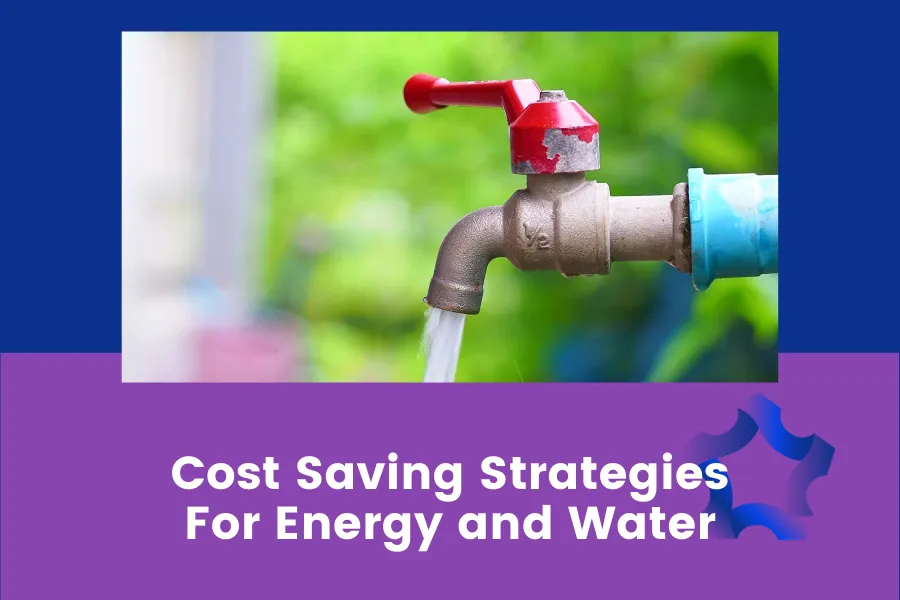Read Our Latest Blogs
Keep up to date on all the latest news.

Cost Effective Water and Energy Savings
Effective Cost-Saving Strategies for Energy and Water Consumption in Organizations
At the end of any quarter, you can be fairly sure the question is going to come up. ‘How can we reduce costs?’ There are a large number of costs that you can try to chisel away at, but to gain consistent long-term payouts, you want to look at the small investments that will put your facility squarely in the black and ready for the future.
Addressing high energy and water consumption is crucial for organizations to control operational costs. The Strategic Conduit has assembled some practical approaches and strategies to reduce expenses while promoting environmental sustainability. Learn how to implement energy and water-saving measures to save money and contribute to a greener world.
Guide to Reduce Utility Expenses
1. Conduct a Comprehensive Energy and Water Audit:
Before implementing cost-saving measures, analyze your business's consumption patterns. Identify areas of high energy or water usage, wastage, and potential inefficiencies. This audit establishes a baseline for improvements, guiding you toward successful cost-saving initiatives.
Key steps in an Energy Audit or Water Audit include:
a. Analyzing utility bills to spot patterns and trends.
b. Inspecting equipment for malfunctioning or outdated components.
c. Surveying the facility for energy and water-saving opportunities.
d. Engaging employees to gather valuable insights and suggestions.
2. Set Clear Objectives and Targets:
Establishing clear goals is essential to drive cost-saving efforts. Determine specific objectives and targets for reducing energy and water consumption. These targets should be measurable, achievable, and aligned with the business's overall sustainability goals.
Examples of objectives could include goals like:
Reduce energy consumption by 20% within the next year
Achieve a 30% reduction in water usage over the next three years.
Implement Energy-Efficient Lighting
Lighting accounts for a significant portion of energy consumption in businesses. Achieve substantial cost savings through the following steps:
a. Replace traditional incandescent bulbs with long-lasting and energy-efficient LED lights.
b. Install motion sensors or timers in low-occupancy areas to automatically control lighting.
c. Maximize natural daylight using skylights, windows, and light tubes.
Want to discover Energy Solutions for your business? Let’s grab 15 mins on the phone.
Water & Energy Conservation Measures for Cost Reduction
Water consumption can also be a significant expense, but there are easy to implement trackable systems that will give you the visibility you need to see the savings stack up.
Start with these measures to reduce water usage and start to define your water management strategy:
1. Install Low-Flow Fixtures: Limit water consumption by installing low-flow faucets, toilets, and shower heads.
2. Address Leaks: Utilize Water and/or Humidity Sensors to regularly check for and repair leaks in pipes, valves, and fittings. Install monitoring systems to catch leaks immediately and minimize waste. Finding a leak quickly can save thousands of dollars on a single leak event. Learn more about our Smart Water Sensors HERE
3. Implement Water Recycling: Consider water recycling or reuse systems, such as rainwater harvesting or greywater recycling, where feasible.
4. Install water flow management devices to ensure the water meters are only measuring water and not AIR, which could account for up to 30% of the water and sewer bill.
5. Promote Water-Saving Practices: Encourage employees to adopt water-saving habits like turning off faucets when not in use and using low-flow fixtures.
6. Adjust Landscaping: Optimize landscaping to reduce irrigation water needs.
How much can you reduce your water bills?
Ready to save up to 30% on your water and sewage bills? Let’s Connect
Embracing Renewable Energy Solutions
Integrating renewable energy sources into your business operations can offset energy costs and reduce reliance on traditional sources. Consider installing solar panels, wind turbines, or other renewable energy systems. Explore options like community solar, power purchase agreements, or virtual power purchase agreements to utilize green energy without the need to invest in your own panels.
Maximizing HVAC Systems for Energy Efficiency: Reduce Costs and Enhance Performance
When it comes to overall energy consumption heating, ventilation, and air conditioning (HVAC) systems can play a significant role.
To optimize HVAC systems and lower expenses, consider these key steps:
1. Regular Maintenance: Ensure efficient operation by regularly maintaining and cleaning HVAC equipment.
2. Programmable Thermostats: Install programmable thermostats to adjust temperature settings based on occupancy and working hours.
3. Improve Insulation: Enhance insulation to minimize heat loss or gain, thus reducing the workload on HVAC systems.
4. Natural Ventilation and Shading: Utilize natural ventilation techniques and shading methods to decrease the need for mechanical cooling.
5. Air Filter Replacement: Implement a consistent air filter replacement schedule to maintain proper airflow.
By implementing these strategies, you can optimize energy efficiency, reduce costs, and contribute to a more sustainable future.
Let’s find some time to talk about your goals in water management, energy solutions, and cost management as well as your company and its needs. If there’s an opportunity to save money or increase efficiency, we are your conduit to results! Click Here

